 |
|

|
 |
TABLE of CONTENTS
 |
New snowplow simulator offers realistic training for snowplow operators |
By Sue Roe

Andrew Kubista, driving simulator program manager, sits in the driverís seat of the new snowplow simulator. He and Brad Swartz will travel to all the districts with the simulator to train MnDOT snowplow operators and employees from cities and counties. Photo by David Gonzalez |
MnDOT’s new snowplow simulator will take to the road in February to train the districts’ snowplow operators and others who operate a single unit truck or a truck-trailer.
The simulator operates like a snowplow and replicates the winter driving situations encountered on the road that challenge drivers to demonstrate proper driving techniques, decision-making skills and reactions.
“The simulator is where we can make the mistakes, learn from them and there are no damages,” said Andrew Kubista, who along with Brad Swartz, conduct the trainings. Both work in the Maintenance Office.
MnDOT has used snowplow simulation training since 2008, but the new simulator is the first of its kind to be used specifically for snowplow training in Minnesota.
“The operator’s viewpoint is more realistic and the scenarios are more interactive with enhanced sound and graphics,” said Kubista. “The controls are the actual ones used on a MnDOT snowplow.”
The simulator can be programmed for all types of situations, from blizzard conditions to roundabouts to tandem plowing.
The training is designed for new and experienced drivers to learn and improve their ability to recognize and react to a variety of road conditions to better manage risk.
The simulator handles six students at a time - two operators who sit in the driver’s seat operating controls and reacting to simulations on two 55-inch screens while four other drivers complete computer-based training. The four-hour training also includes instructor-led classroom participation.
Several courses are available, including hazard avoidance, truck box clearance and usage, snowplow handling and underbody usage, and precision driving and backing.
One of the simulator’s other components is a reaction test that measures the distance traveled between the driver’s observation of and reaction to hazards on the screen.
“This helps make the driver aware of his or her skill level and it’s something they can improve,” said Kubista. “Driver results are retained for comparison with future training and testing.”
The simulator is housed in a 32-foot trailer with a classroom slide out. Having the simulator and classroom trailer in the same space allows training to take place at any location in the state. Kubista said this eliminates travel time for participants and makes the training accessible and affordable.
All MnDOT snowplow drivers will be given the opportunity to attend the training as the trailer travels to all the districts. In February, the training will start in District 2 and then District 4.
Customized scenarios are available for emergency management, fire departments, and city and county personnel who drive a single unit truck or combination truck-trailer.
Kubista said companies whose employees took the simulator training reported reductions in the number and severity of crashes, lower vehicle maintenance repair costs, and improvements in fuel efficiency.
“Our goal is to train our snowplow operators in a way so they are knowledgeable and skilled as they encounter the hazards of winter on the roads,” said Kubista. “MnDOT’s investment in this training will better complement the training efforts currently made available to reduce the number and severity of crashes.”
In this video, Andrew Kubista, driving simulator program manager, describes the snowplow simulator program and the new simulator used to train snowplow operators. Video produced by Rich Kemp |
|
 |
|

|
 |
TABLE of CONTENTS
 |
Metro District uses animated videos to prep motorists for traffic changes during future I-694 project |
By Chris Krueger, Metro District public affairs director
This is one of three short animated videos to explain traffic flow through the I-694 construction project. Video courtesy of Metro District |
Metro District is piloting three short animated videos to explain traffic flow through construction this spring on Interstate 694 between Rice Street and Lexington Avenue.
“People are busy, so we’re trying new ways to provide helpful information that we hope engages their attention for a couple of minutes,” said Scott McBride, Metro district engineer. “Our goal is to keep traffic moving safely and efficiently by helping motorists know what to expect during construction.”
In spring 2016, MnDOT will add a lane to each direction of I-694 between Lexington Avenue in Arden Hills and Rice Street in Little Canada to increase highway capacity, support economic development and improve freight movement. The $35 million project was funded through the Corridors of Commerce program created by the 2013 Minnesota Legislature.
The animations explain the work to take place this spring, why it is needed, and how to travel safely through the area during construction. MnDOT is releasing the videos through a targeted social media campaign that makes links easy to share on Facebook and Twitter. The project also has a hashtag, #enhance694, to help motorists quickly find all updates related to the project. The project team also will use an electronic billboard along I-694 in Shoreview to inform drivers that construction is coming.
MnDOT will continue to use traditional media, emails and text alerts to communicate about this project.
The I-694 project website, mndot.gov/enhance694, provides a variety of information, including a construction schedule, contact information and videos. The website also includes a link for businesses in the area and allows people to sign up for project email updates and text alerts, and connect with MnDOT on Facebook and Twitter. |
 |
|

|
 |
TABLE of CONTENTS
 |
New research selected with eye on results |
|
By Mike Foley, Research Services & Library
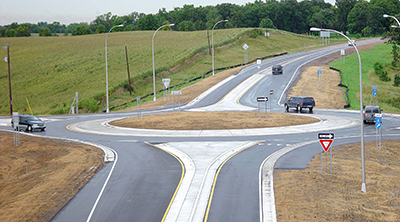
Traffic engineers would like more guidance on how to slow down traffic approaching roundabouts at high-speed intersections. Shown is Scott Countyís first roundabout at Highway 13 and County Road 2 before signage improvements were made. Photo courtesy of Scott County |
Minnesota’s latest crop of transportation research projects has been identified. This year, researchers were asked to pay special attention to how their work could benefit the public and be put into real-world practice.
MnDOT’s Transportation Research Innovation Group and the Minnesota Local Road Research Board announced their fiscal year 2017 funding awards last month after hearing proposals from researchers at multiple universities. The two bodies chose 20 research proposals totaling approximately $2.9 million that will study new and innovative approaches to improve the environment, make transportation systems safer, improve construction methods and operate in more cost-effective ways.
According to Hafiz Munir, research management engineer, MnDOT Research Services made some key changes to its annual requests for proposal that will help ensure research makes a difference to the agency’s bottom line. This year, researchers were asked early in the proposal process how they would quantify their results, what benefits the research could achieve and how their research could be implemented in the future.
“Now we’ll be able to track those metrics and that will help MnDOT not only quantify the potential benefits of the projects, but also implement the results,” Munir said. “The bottom line is that we will be able to not only save money, but also improve the way MnDOT does business.”
Several projects deal with improving transportation safety, Munir said, and many others are focused on implementing cost-saving practices, innovations and new technologies.
The following projects approved in December 2015 will:
Munir said the next steps for these projects this spring include creating technical advisory panels, finalizing project work plans and preparing contracts. Some projects could begin early, depending on available funding and project readiness. By the time fiscal year 2017 begins on July 1, funding will be available to begin all 20 projects.
Want to solve a problem at MnDOT? Submit your idea now.
MnDOT is soliciting research implementation ideas for FY 2017 funding. The agency will allocate approximately $1 million in funding for projects that improve the transportation system and make MnDOT run more efficiently. Write a short summary of your idea on the Ideascale website by Feb. 10. Once you submit your idea, Research Services staff will provide you more information about the selection process and help you develop a work plan. Last yearís implementation cycle included projects to provide live-stream images of traffic conditions from snowplows, a tool to determine optimal spacing for MnPASS high-occupancy lanes and a system for evaluating potential sites for railroad crossings to improve safety.
|
|
 |
|

|
 |
TABLE of CONTENTS
 |
Creating a culture of safety pays off for District 1 border sub-area employees |
By Beth Petrowske, District 1 public affairs coordinator

These Border Sub-Area employees, stationed at the International Falls truck station, were extremely enthusiastic about sharing ways that they make work safe. (From left) Dustin Christopherson, transportation associate; Brett Lyczewski, transportation associate; Ted Etienne, transportation generalist; Matt Lessard, transportation generalist. Photo by Beth Petrowske |
District 1’s border sub-area recently achieved a major milestone by working through all of 2015 without a single motor vehicle incident or work-related injury.
So how did they do it?
There’s no single, simple answer, but Chris Cheney, border sub-area supervisor says some of the reasons are “training, daily vigilance and teamwork.”
“Chris is a good communicator and employees understand his expectations,” said Steve Pecharich, District 1 safety administrator. “He’s good at explaining how and why safety is important. He’s also very approachable — people feel comfortable talking to him.”
MnDOT management wants all employees to know that safe work practices are valued as much as work quality and production. Cheney emphasizes this regularly so everyone understands that following safety procedures is as important as charging out material correctly or completing bare lane reports accurately and on time.
Creating a safe work environment
During a recent visit to the border sub-area, Cheney and several employees from the Cook and International Falls truck stations shared some of their beliefs regarding work safety. According to the team, these items work together to create a safe work environment.
- Learn and practice safety every day “Do it Right Do it Safe.”
- Never become complacent — this is often when injuries occur.
- Share ideas and observations that affect safety. Employees in the border sub-area make a practice of leaving notes for relief operators at shift changes to alert them of anything important they observed during their shift. They also have a white board they use to share timely information.
- Make sure everything needed is on-hand when a project starts; this allows everyone to focus on the work and work at a safe pace.
- Take the time needed to work safely. “Slow is smooth…smooth is fast” - this military saying is based on the belief that doing something deliberately and carefully gets the job done faster and more efficiently than trying to rush.
- Everyone should feel comfortable stopping another person if they observe something that isn’t safe. Show that you care about the well-being of co-workers. Acknowledge positive safety performance.
- If someone needs help, don’t wait to be asked; jump in and help.
- Be positive at work, but understand that everyone has bad days. Make an effort to realize that a person may be cranky at times…move on; don’t let it be a distraction.
- Leave trucks, equipment and shared work areas in the condition that you would like to find it when your shift begins. Follow the Golden Rule; it makes a big difference when people really care about each other!
- Everyone has different skill sets, so find out what they are and plan work accordingly. Allow less experienced employees to learn from more experienced employees.
- If you discover a safer way to do something, let others know.
- Be diplomatic. Share information without making others feel stupid. If someone is having trouble with a task, suggest they watch someone else do it for a while. Or share information using casual approaches like, “I’m just throwing this out there…have you ever tried it this way?”
- No one knows everything. Even 20-year employees have questions and can learn something new.
- Ask for help if you need it. Struggling to do something alone often leads to injuries.
“The effort you put toward safety pays off exponentially,” said Cheney. “Serious injuries affect how you feed your family, your mobility and can cause lifelong pain, suffering and medical costs. Nobody wants that.”
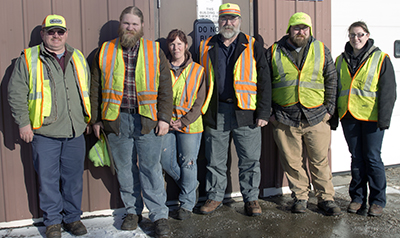
Each of these border sub-area employees provided at least one anecdote about how a focus on safety has benefited them at work. From left are Mike Francisco, transportation generalist; Colton Cheney, transportation generalist; Mitzi LaNier, transportation generalist; Chris Cheney, border supervisor; Zachary Cheney, transportation generalist; and Samantha Sever, transportation associate. Photo by Beth Petrowske |
Mentoring
Each new employee in the border sub-area is assigned a mentor and the mentorship never ends.
Beside the assigned mentor, all co-workers help mentor new employees as they learn new tasks and job duties.
“New folks come on and we teach them about bad hills and curves,” said Mike Francisco, border sub-area transportation generalist specialist. “The mentor-program really helps new employees by giving them a heads-up about things they otherwise might have to learn the hard way.”
Cheney sees importance in developing new employees. He says that in addition to the annual snow and ice and summer prep meetings, bi-monthly safety review meetings are beneficial for new employees to learn from more experienced employees in a setting that makes them feel more comfortable asking questions.
Watching out for “the other guy”
Borderland plow operators often encounter impatient logging truck drivers who don’t like to wait behind slow-moving plow trucks. Colton Cheney, transportation generalist, has encountered this many times and tries to reduce the chances of a crash by using his personal portable CB radio to contact the logging truck operator.
“I know you're behind me… there’s a good passing spot one mile ahead,” said Cheney. “When I do this I often get a thank you, instead of someone mad at me.”
Work attitudes like this not only improve safety, but they project MnDOT in a positive light.
So does it all sound too perfect? Not quite. The borderland employees have their share of difficulties just like all work places, but they have a safety culture that helps them through the good days and the more challenging ones.
|
 |
|

|
 |
TABLE of CONTENTS
 |
Capital Highway Information Management Enterprise System designed to track funding details |
|
By Judy Jacobs
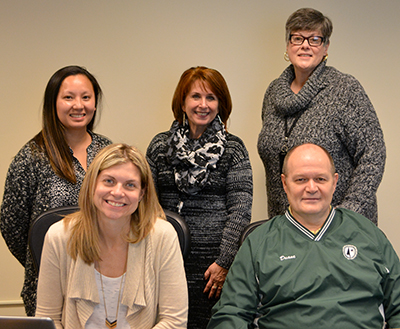
The Capital Highway Information Management Enterprise System will help track funding details. CHIMES was developed by (back row) Kha Vue, Office of Transportation System Management; Deb Brinkman, MN.IT project manager; and Debra Hipp, Office of Transportation System Management. (front row) Kristy Jelen, MN.IT business analyst; Duane Leurquin, CHIMES project director. Core team members missing from the photo: Brian Gage, Office of Transportation System Management; Patrick Weidemann, Office of Transportation System Mangagement; and Sue Thompson, Office of Financial Management. Photo by Rich Kemp |
Currently in the design phase, a new program called the Capital Highway Information Management Enterprise System, or CHIMES, will soon be able to help track funding details for the MnDOT Capital Highway program and other projects.
This program will also be able to help manage program and project funding sources; help the districts manage program and project funding and approvals; produce the State Transportation Improvement Program; and report total project cost and total project costs estimates, providing a single, authoritative source for project funding data. Other benefits include replacing existing Program and Project Management System functionality, reducing or eliminating redundant data with the capability of producing analytics and legislative reports.
CHIMES will share data with and use data from other systems through MnDOT’s data warehouse. These systems include PPMS, P6, SWIFT, PUMA and AASHTOware.
“We need to be cohesive about how we collect and use the Capital Project data,” said Tracy Hatch, deputy commissioner, chief financial officer and chief operating officer. “The new system moves away from the multiple spreadsheets of data that we’ve used in the past. As the source for project funding data for all external inquiries, CHIMES will help enhance financial effectiveness, ensure consistency in our message and build public trust with added transparency in project and program changes and MnDOT’s funding processes.”
CHIMES will become the source of information for project funding, target and budgets, letting dates and MnDOT trunk highway capital performance indicators. It will also be used to produce Minnesota’s State Transportation Improvement Program for approval by the Federal Highway Authority and the Federal Transit Authority.
Storing target and budget data that calculates against programmed project dollars will allow MnDOT to better manage the budget authority given by the Minnesota Legislature and maximize available funds.
Next week all MnDOT employees will receive a short survey to determine who is currently using PPMS and its reports. A follow-up survey will be sent to those employees who indicated they are PPMS users or regular users of its reports and will ask for more detailed information about what data is currently being used by that employee. This will help to ensure all of the remaining PPMS information and functionality that is still needed is included in CHIMES.
Working with a team of district and expert office representatives, the CHIMES team will determine the system of record for project data used in multiple systems to reduce redundancies, inefficiencies and data errors.
“We want to make sure that nothing is missed when the CHIMES application is being built,” said Duane Leurquin, CHIMES project director. “We are starting at ground zero because we want to do the right project.”
In addition, Leurquin and his team are conducting peer reviews with several other states including Wyoming, Nevada, Colorado, Louisiana and Texas.
Leurquin stepped out of his role as Financial Management director and, with his expertise and experience in the financial field and capital highway program management, is uniquely qualified to lead the CHIMES team. Robin Sylvester is currently serving as acting Financial Management director.
Each of MnDOT’s eight districts has a project-specific 10-Year District Capital Highway Investment Plan, found below. To access the 2016-2025 10-Year Capital Highway Investment Plan, click on Download the plan.
To learn more--and keep up-to-date with--the CHIMES project, visit the program website at http://ihub.dot.state.mn.us/chimes/.
|
 |
|

|
 |
TABLE of CONTENTS
 |
Training group changes name, but continues to produce e-learning products |
By Rich Kemp
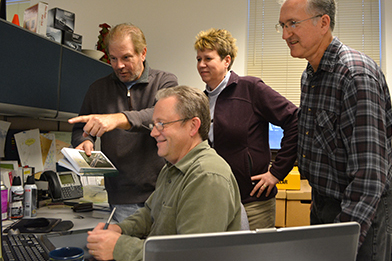
The E-learning Services Group (clockwise from left) Joe Shultheis, instructional designer; Laura Lochen, instructional designer; Gene Olchefske, production manager; and Dave Sundberg (seated), production specialist; look at an e-learning module Sundberg is working on. The team works at the Shoreview Training and Conference Center. Photo by Rich Kemp |
Ever wonder where those online training courses come from? MnDOT offers many courses that can be taken online. The E-learning Services group creates e-learning programs that combine video, graphics and 3D animation into an interactive format. The group started in 1999 and was previously known as the Multimedia Development Group until the name change in 2015.
These e-learning modules are created as an alternative type of training method, which is always available online. With the training available online anytime, the learners don’t have to incur the same level of travel costs and time away from work as traditional classroom learners. Employees don’t have to wait for the next class; they can take it whenever they want to.
Benefits of the e-learning training include:
- Ability to reach a geographically diverse audience
- Available for just-in-time training needs (365 days, 24/7)
- Consistency of training
- Self-paced learning
- Cost-effective by reducing travel and instructor fees
- Custom-built content which targets MnDOT's unique training needs
“When someone comes to us, we set them up with one of our instructional designers,” said Gene Olchefske, Elearning Services production manager. “They work together to write an interactive script for the e-learning module and add an assessment to verify that the student has learned the material.”
One of the two instructional designers, Laura Lochen or Joe Shultheis, meet with the client to gather information. Once the script is complete, they sit down with the client and a production specialist, either Olchefske or Dave Sundberg, to ensure the script is ready for final production.
The production specialist will get photos from the client or take any needed photos. They will create animations, interactions or videos and then use the visuals with the script to create the e-learning module.
“We like to put interactions in the training to keep people engaged, and improve the learning experience and retention” said Olchefske. “But we are very diligent about accessibility. We want to make sure everyone can access the training.”
Once the e-learning modules are complete, they are added to the Learning Center so that MnDOT employees can access them. If cities or counties also need to access the lessons they are hosted on an external server.
To get an e-learning lesson created or for more information on Elearning Services, contact Gene Olchefske at 651-366-5245.
This video promotes the e-learning team and the products they produce. Video produced by the e-learning team |
|
 |
|

|
 |
TABLE of CONTENTS
 |
Whatís new on the web |
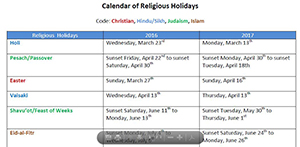
A list of religious holidays can be found on the Diversity and Inclusion website to help schedule meetings and conferences in more inclusive way. |
Calendar updates on Diversity and Inclusion website
Employees can schedule conferences or meetings in an even more inclusive way, thanks to MnDOT’s calendar of religious holidays (PDF) now on the Diversity and Inclusion website. The calendar includes holidays for employees who practice Christian, Hindu/Sikh, Judaism, and Islam religions. For more information about religious holiday dates, contact Rosemarie Merrigan, Office of Equity and Diversity.
New Library Materials posted on the web
New Library Materials are available at www.mndot.gov/library/newlibmat.html. This issue includes a few DIY tips, mainly for MnDOT employees.
New Library Materials is a compilation of new titles and other resources added to the library collection during the previous month. To be added to the distribution list, contact pamela.m.gonzalez@state.mn.us or 651-366-3749.
Previous editions of New Library Materials are archived and available at www.dot.state.mn.us/library/recacq-archive.html. For other information requests, contact the Library at 651-366-3791 or e-mail library.dot@state.mn.us, or send requests via the Ask a Librarian web page.
|
 |
|

|
 |
TABLE of CONTENTS
 |
MnDOT receives Governor's Continuous Improvement award |
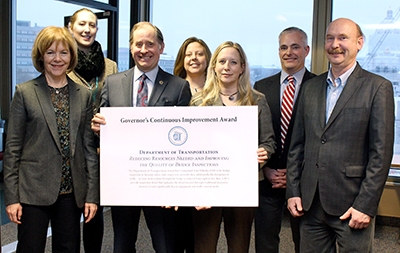
Lt. Gov. Tina Smith presented MnDOT with a Governor's Continuous Improvement award Jan. 14. Present for the ceremony were (counter-clockwise from left) Smith, Commissioner Charlie Zelle; Jennifer Zink, bridge inspection engineer; Bruce Holdhusen, research and implementation program development engineer; Barritt Lovelace, Collins Engineering regional manager; Tracy Hatch, deputy commissioner, chief operating officer and chief financial officer; and Tara Kalar, associate legal counsel. Photo by Shannon Fiecke |
MnDOT received a Governor's Continuous Improvement award during a ceremony Jan. 14 at the Veterans Services Building. In partnership with the Governor's Office and the Better Government for a Better Minnesota initiative, the Minnesota Office of Continuous Improvement recognized significant individual and organizational achievements from across Minnesota government.
All state agencies and boards were invited to participate by nominating projects from individuals or teams that have increased the efficiency, quality and value of state government services, using continuous improvement tools or other related methods.
MnDOT received the award for Reducing Resource Necessary/ Improving Quality of Bridge Inspections. The agency found that using Unmanned Aerial Vehicles, or drones, for bridge inspections decreased safety risks inspectors face. Additionally, the disruption to traffic during bridge inspections was reduced from eight days to five days. UAVs provide inspection detail that replicates the detail learned through traditional measures; however, it costs significantly less in equipment and traffic control needs.
"It is an honor for MnDOT to receive this award recognizing the good work we are doing to continuously improve important processes,” said Nancy Daubenberger, Engineering Services Division director. "The use of UAVs is something bridge inspectors pursued to improve the quality and safety of bridge inspections and reduce impacts to traffic, and it proved to be beneficial."
In summer 2015, MnDOT used UAVs to inspect four Minnesota bridges and to test the effectiveness and possibilities of using them to aid in bridge inspection work. The UAVs performed a variety of inspection functions, including gathering high-quality still images and video footage. The UAVs also collected data from infrared cameras and provided the ability to capture data needed to construct maps of bridge areas and 3D models of bridge elements. |
 |
|

|
 |
TABLE of CONTENTS
 |
2015 accomplishments highlight MnDOTís commitment to serving Minnesota |
By Commissioner Charlie Zelle

Commissioner Charlie Zelle. Photo by David Gonzalez |
One of the best parts of my job is telling people—the public, governor, legislators and partners—what a smart, innovative and committed group MnDOT employees are. You are the heart and soul of this agency, contributing in many different ways to provide safer, smoother roadways and to maintain the state’s transportation network that is so vital to Minnesota’s economy and quality of life.
Here are just a few examples of the great work you helped accomplish in 2015:
- Enhancing financial effectiveness and efficiency – MnDOT identified more than $63 million in savings statewide, from applying emerging pavement research to optimize pavement thickness, to deploying towplows and installing LED lights. Many MnDOT working groups also worked on smaller efficiency projects, known as OWSAs; these saved money by improving processes and using innovative ideas. In addition, the agency instituted an asset and property management program to ensure the long-term viability of the $38 billion in state assets managed by MnDOT.
- Telling the transportation funding story – MnDOT continued its public outreach to build awareness about Minnesota’s transportation system and the looming gap between funding and system needs. We met with dozens of editorial boards, chambers of commerce and other groups interested in transportation and wrote opinion pieces for newspapers statewide, detailing the issues. Although the 2015 Legislature failed to act on a long-term transportation funding solution, MnDOT continues to build momentum and public support for the issue so it can be addressed during the 2016 legislative session.
- Managing statewide construction – MnDOT worked on 290 road construction projects, completing 127 of them. Another 59 projects helped improve safety at railroad crossings, and made improvements on runways and terminals at regional airports. The work provides safer, smoother roadways and maintains the state’s transportation network. See the Nov. 10, 2015 Newsline for more details.
- Fostering innovation – The Winona Bridge was named one of the top 10 bridges of 2015 in the November issue of Roads and Bridges magazine. Currently under construction, the bridge is expected to open to traffic in late 2016. Among other features, the magazine’s editors noted MnDOT’s use of the Construction Manager/General Contractor method, an integrated approach to planning, designing and constructing a project. The Winona Bridge project is MnDOT's first project using the CM/GC delivery method. (It’s also now being used on the Hwy 53 relocation project in Virginia.)
- Improving bridge inspection safety – MnDOT looked at the effectiveness of using unmanned aerial vehicles (drones) to aid in the inspection of Minnesota’s 20,000+ bridges (4,500 of which are on the state highway system). The research team found that using drones could help MnDOT decrease the rising costs of bridge inspection while minimizing risks associated with current bridge inspection methods. This effort was recognized with a Governor's Continuous Improvement award this month.
- Enhancing real-time road condition information – MnDOT is constantly trying to find ways to improve road information for travelers. This year, we enhanced the 511 traveler information system by adding real-time photos of road conditions from 92 camera locations along state roads and interstates. These camera locations are in addition to the more than 800 traffic cameras already displaying road condition information on the 511 system.
- Improving safety on rural roads – Sixty-six percent of fatal crashes in the state happen on rural roads. MnDOT installed the Rural Intersection Conflict Warning Systems to help reduce crashes and improve safety at 54 high-risk locations around the state. The systems alert drivers when vehicles are approaching an intersection through a combination of traditional signing, flashing lights that turn on when traffic is approaching an intersection and sensors that trigger the lights to flash.
- Improving rail crossing safety – MnDOT spent $6.5 million in state and federal funding in 2015 to install new rail crossing signals and gates, and replace older equipment to reduce train-related incidents with vehicles and pedestrians. According to the Federal Railroad Administration, in 2014, 59 vehicles were involved in incidents with trains, resulting in 10 fatalities in the state.
- Promoting transportation alternatives – MnDOT completed the final phase of a three-year project installing signs to mark the 800-mile Mississippi River bicycle trail in Minnesota. The Mississippi River Trail runs from the headwaters in Itasca State Park in northern Minnesota to the Iowa border. It is part of a 10-state route that ends at the Gulf of Mexico. Minnesota’s route is on roads, paths and trails along the river with options that include sections of the Paul Bunyan and Heartland state trails and sometimes both sides of the river. The signs help cyclists navigate the route much easier, and at the same time, alert motorists that there may be bicyclists on or near the road.
- Recognizing transportation planning excellence – The Federal Highway Administration and Federal Transit Administration presented MnDOT with one of eight Transportation Planning Excellence Awards. MnDOT was recognized for the 20-Year State Highway Investment Plan, which draws on public input to guide capital investment plans for transportation projects along the state’s 12,000-mile network of highways.
- Managing property assets – MnDOT piloted a project to sell surplus right of way. It hired a consultant to identify parcels that might be good candidates for selling. The work resulted in at least $1.7 million worth of property sales since May 2014, with more than a million dollars in offer letters out. In addition to getting excess property back on the tax rolls, the revenue from property sales go into Minnesota’s trunk highway fund, which supports the construction and maintenance of highways throughout the state.
There are so many more accomplishments this agency has achieved during the past year, so many more awards that could be listed here. Each is important, valued and contributes to MnDOT’s mission. Thank you for all you do each day to make a safe, accessible and reliable transportation system for Minnesota.
Editor’s note: In the next issue, Commissioner Zelle will talk about the agency’s goals for 2016. |
 |
|
| |
|



